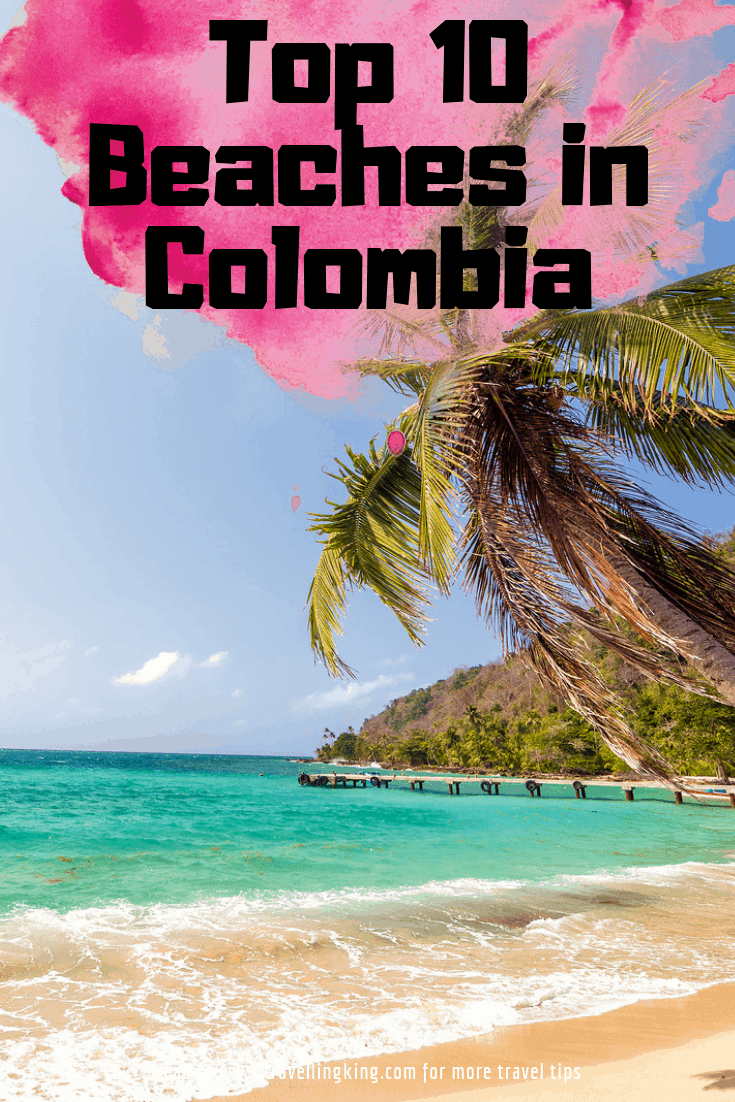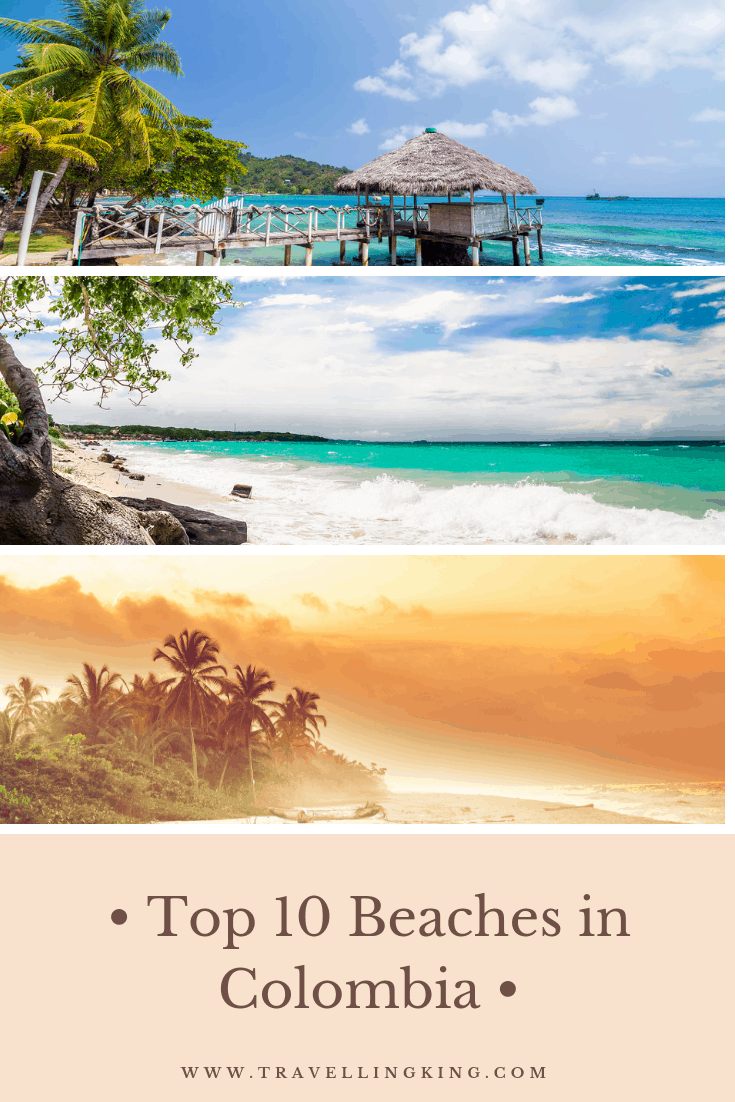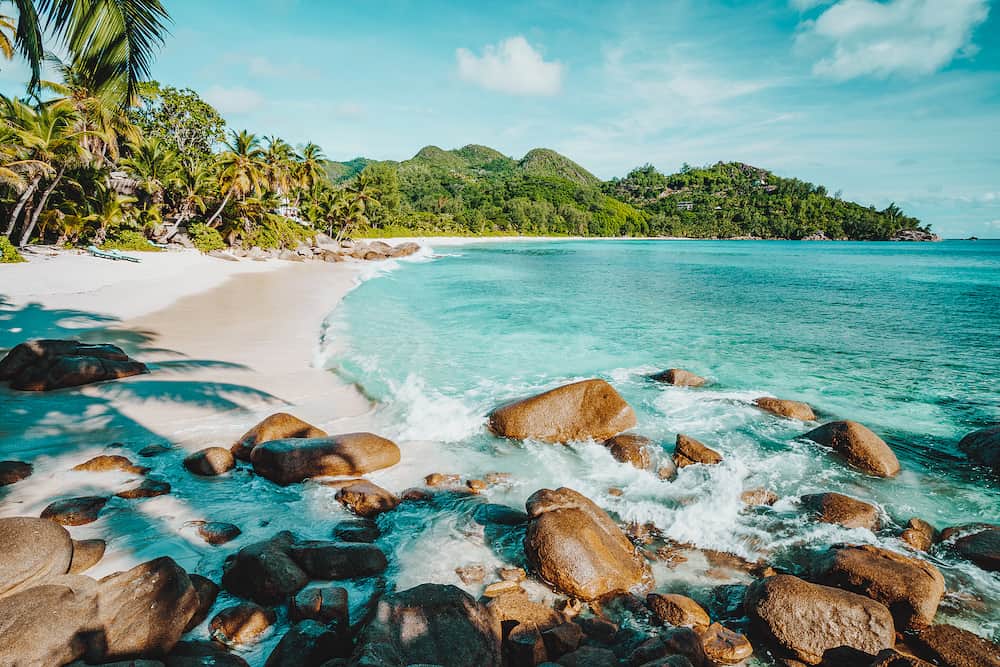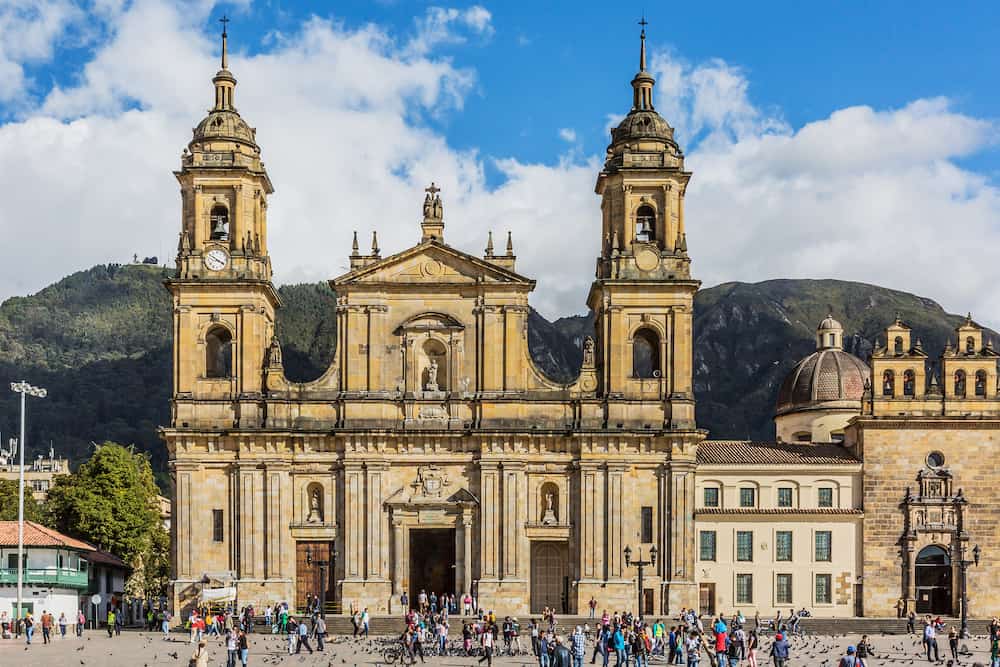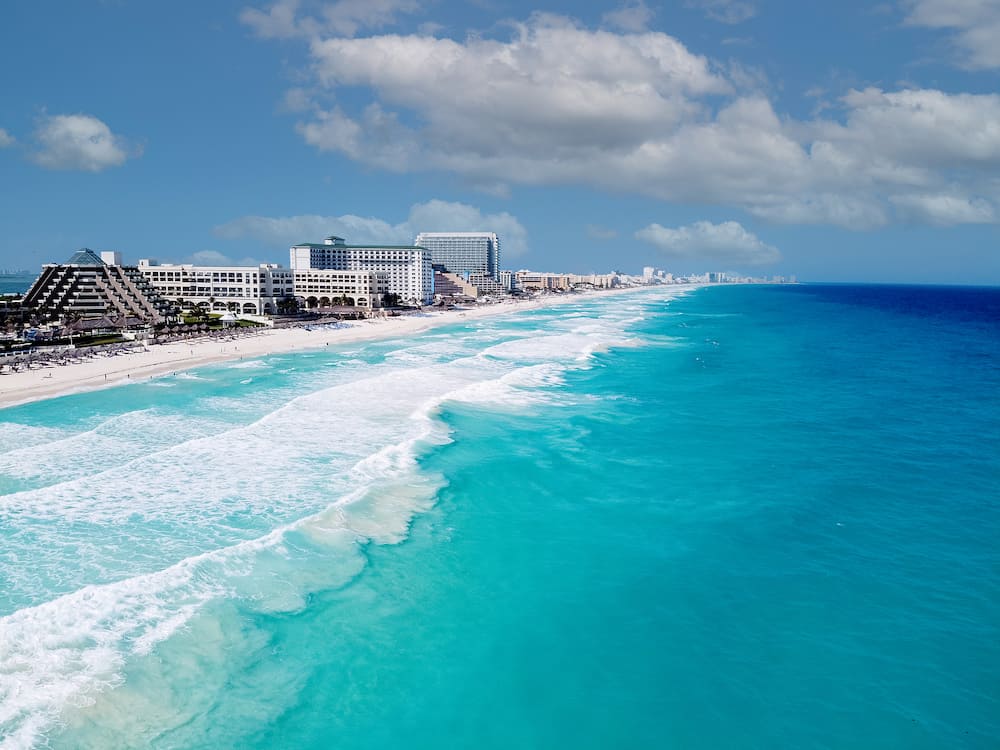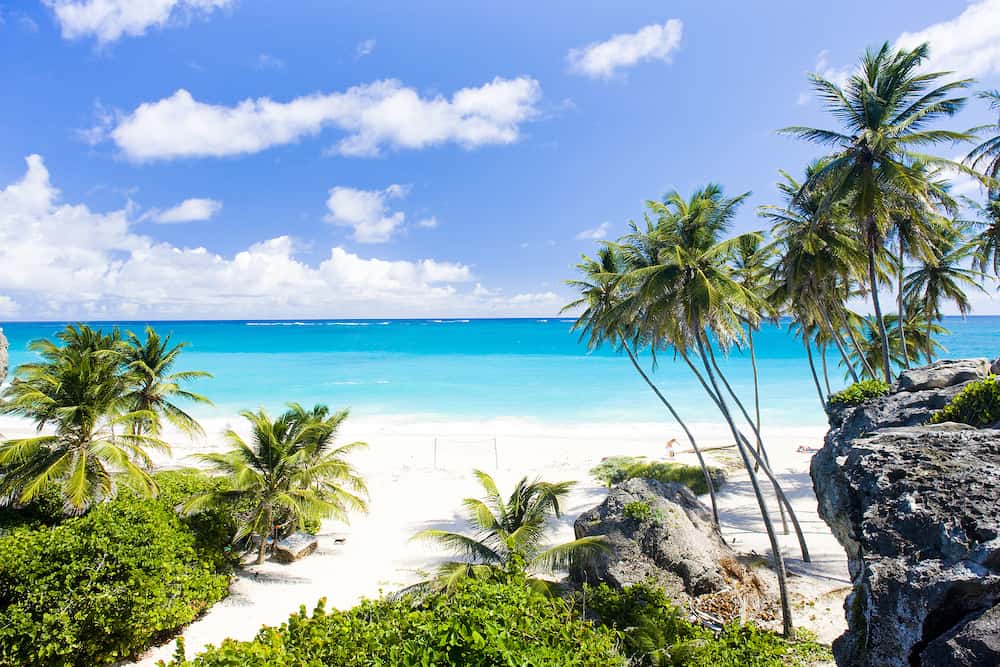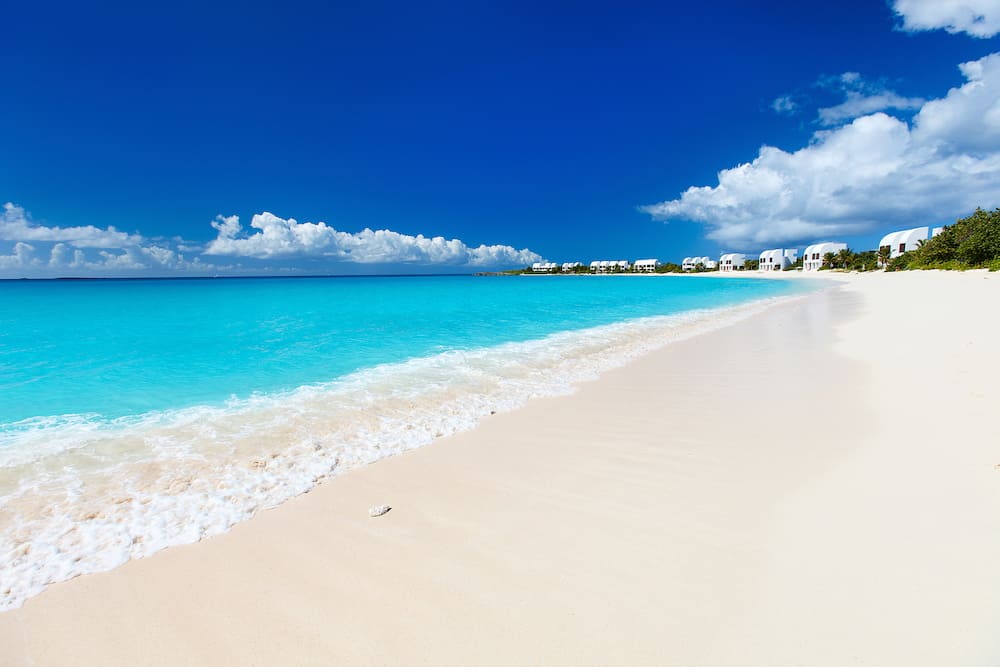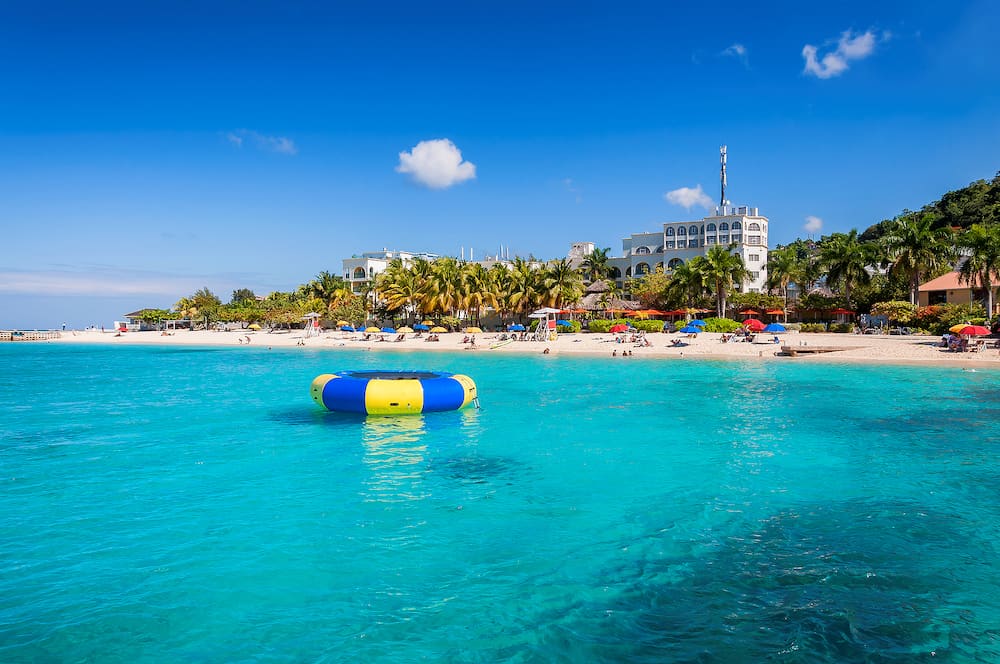Top 10 Beaches in Colombia
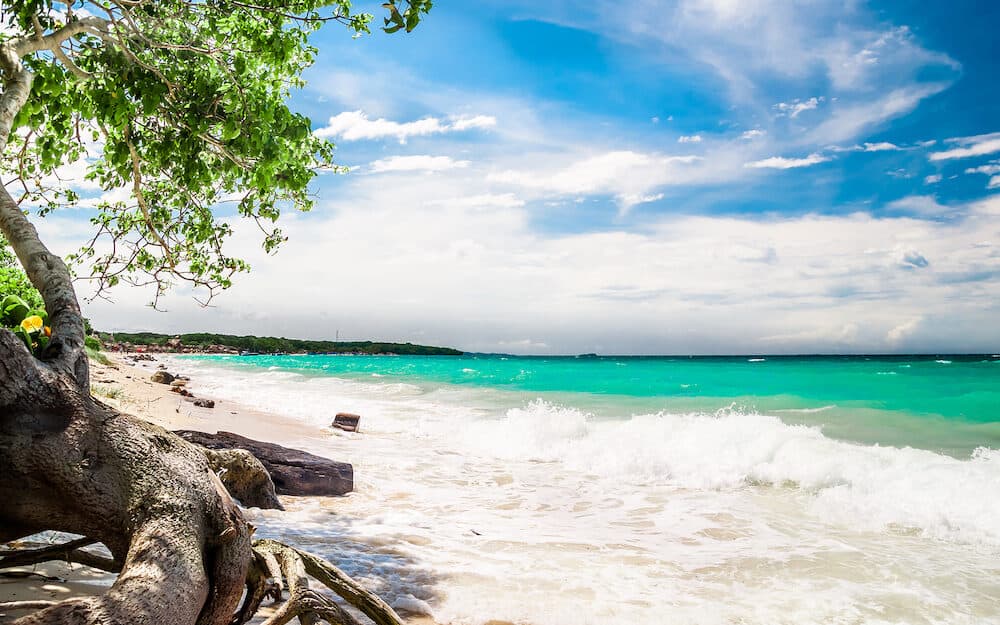
So you’ve made the right decision to spend some time exploring beautiful Colombia. Whether enjoying a vacation from work or making your way through the region as part of an extended trip, you will find that Colombia is a country that has so much to offer.
From the Amazon rainforest, to the Andes mountains, to the Caribbean Coast in the North and the Pacific Ocean in the West, Colombia would be the most biodiverse country in the world (if it wasn’t for Brazil)!
You can spend your days exploring one of the culturally rich cities, or learn anything and everything about coffee in Zona Cafetera, the largest coffee region in the world. For most of us, our dream Colombia vacation also involves relaxing on white sand beaches, surrounded by a forest of palm trees, and looking out into crystalline blue waters.
With 3,200 km of coastline, and the only country in South America with both the Caribbean Sea and the Pacific Ocean, it is no doubt that Colombia has some of the most beautiful beaches in the world.
Whether you’re looking for a quiet, isolated beach escape, a strenuous beachside jungle hike, looking to catch some waves, or maybe even a wild party, Colombia has enough beaches and islands to meet any travelers’ needs.
Please note that December and January is summer vacation for the neighbors in the south, so you will find an unreasonable amount of people at the popular beaches. If possible, avoid beach travel in those months, unless you don’t mind wild hordes of people.
You can learn about and from the Colombian culture by immersing yourself with locals, the kindest and liveliest people ever, while enjoying the coast in the north, the west, or hopefully both! Word of caution though, once you get too comfortable on Colombia’s coasts, you will find it nearly impossible to leave.
Who knows, you may do what the most of us do, and end up staying in Colombia much longer than planned, or maybe even never coming home! Here are my top 10 beaches in Colombia.
Plan your trip
Save on fees abroad with the Wise Card—use it at ATMs, restaurants, and for flights or hotels in over 150 countries. Manage 40+ currencies in real-time with the Wise app.
Need Help Planning?
- Cheap Flights: Find the best deals.
- Accommodation: From hostels to luxury stays.
- Car Rental: Affordable options worldwide.
- Sightseeing Tours: Explore without breaking the bank.
- Travel Adapter: One adapter for all your needs.
- Travel Insurance: Don’t risk it—stay covered.
This post includes affiliate links. Read my full disclosure and content policy.
San Andres Island
San Andres Island is one of the three islands that make up the San Andres Archipelago, found in the Caribbean Sea northwest of Cartagena, but actually much closer to Nicaragua (about 150 miles off the coast).
These islands are the perfect way to experience the true blend of Colombian and Caribbean culture, as you relax on white sand beaches and enjoy the “Mar de Siete Colores” (seven colored sea).
Being the largest and most accessible of the three, San Andres Island is fairly popular amongst Colombian tourists as the country’s well kept, hidden paradise.
Most people who decide to make the quick flight over will find themselves relaxing on the beaches of San Luis, Playa Charquito, or Spratt Bright on the main island. If you’re looking for an even more private and serene beach experience, I recommend taking the extra trip out to Providencia Island.
Providencia is a protected island and less developed, with beautiful empty beaches surrounded by palm trees and mangroves. It is famous for its crystal clear waters, allowing for great diving and snorkeling conditions.
Of course this all comes at a price, as both the 20 minute flight and the 2.5 hour boat ride from San Andres to Providencia is not exactly budget friendly.
For the majority of us, San Andres Island will be the slice of beach heaven we dream of, and worth the quick hop over from mainland Colombia.
There are daily flights from major cities in Colombia, as well as from San Jose or Panama City, to the airport on San Andres Island.
Although flights tend to be quite affordable, you will find life on the islands to be a bit more pricey. If you only plan to spend a few days here, I recommend bringing some food for cooking to save on additional costs.
A visit to San Andres Island is the perfect way to end your South American backpacking trip, enjoying some quiet, tranquil beachtime before heading home and snapping back to reality.
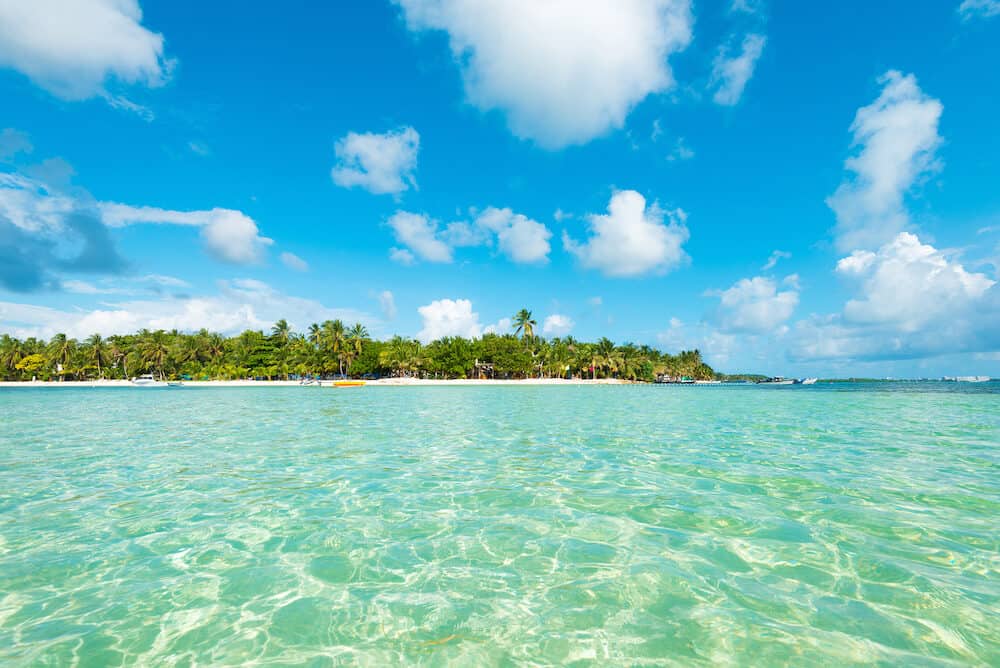
Archipelago of San Bernardo
About 80 km south of Cartagena, you will find a chain of 10 islands called San Bernardo Islands. These islands are quite unknown, unless you’re a Colombian local, and is a piece of paradise for anyone looking to get off the beaten path.
Small islands of white sand, palm tree forests, mangrove lagoons, all surrounded by crystalline blue waters… I don’t know why anyone would want to miss out on what these islands have to offer!
Situated on the Caribbean coast, these islands are easily accessible by a 2 hour bumpy boat ride from Cartagena, but if you’re nervous about getting motion sickness, I recommend taking a bus south of Cartagena to Tolu, then taking a boat from there.
It is advised to catch a boat earlier in the day when the ocean is calmer, and the journey is possible. Please note that there are no ATMs on the islands, so make sure you have sufficient cash, and maybe even bring some food as options are limited and expensive.
The most popular islands are Mucura, Tintipan, and Isla Palma, all of which have accommodation options. Santa Cruz island is also worth visiting to check out one of the most densely populated islands in the world!
Mucura island tends to see the most visitors flocking over for the white sand and calm, shallow water. The island offers small beaches all around its coast, and palm trees covering most of the island.
This island offers the cheapest hostels and best food options. Tintipan island is the largest of the islands but much quieter than Mucura. This island is famous for its mangrove swamps, exotic birds, including sights of pelicans and flamingos, and great snorkeling.
You can snorkel in the crystal clear waters amongst colorful reefs and fish, or even go for a night swim surrounded by bioluminescent plankton. Tintipan is the ideal postcard image of beautiful beaches.
You may have heard of Casa en el Agua, a hostel occupying its own island. Although not part of the 10 islands of San Bernardo, this hostel is quite near.
If you’re looking for a once in a lifetime hostel experience, and a fun night of private island partying, then I recommend getting out here for one night!
The San Bernardo islands are the perfect place for those travelers looking for some rest and relaxation. The islands used to just be local indigenous Caribbeans, but is slowly gaining popularity amongst vacationing Colombians.
Time to add these islands to your itinerary, because in due time it might just be another popular hotspot for foreign travelers!

Playa Blanca at Isla Baru
Isla Baru is an island a bit southwest of Cartagena and hosts one of the most popular beaches in all of Colombia, Playa Blanca. Being a jungle covered island with pearl white sand and clear turquoise water, it makes sense why this beach is so popular, but of course with popularity comes large, and usually unwanted, crowds.
Isla Baru is one of the many chains of Colombian islands in the Caribbean Sea, and easily accessible from Cartagena.
You will find there are heaps of different tours that offer day-trips to the island, and even continue on to Isla Grande (part of the Rosario Islands). If you’re looking to beat the crowds, or even spend a night or two on the island, it is also possible to arrange a shuttle or speedboat independently.
Playa Blanca is famous for its warm waters that makes it ideal for a nice dip in the ocean. The beaches here are far cleaner than what you will find in Cartagena, but with everyone having the same mindset, many people will make the journey here.
If you are someone who’s looking to avoid crowds for a quiet tranquil beach experience, you might want to leave Playa Blanca out of your itinerary.
If you’re spending a few days in Cartagena, then it’s definitely worth a day trip to enjoy the strong sun and warm water.
Upon arriving to the island, you will be hassled by many vendors selling fruit, seafood, jewelry, you name it. Although bothersome at first, I definitely didn’t regret the fresh cup of mangoes I got to enjoy wading through crystalling water and absorbing the Caribbean sun.
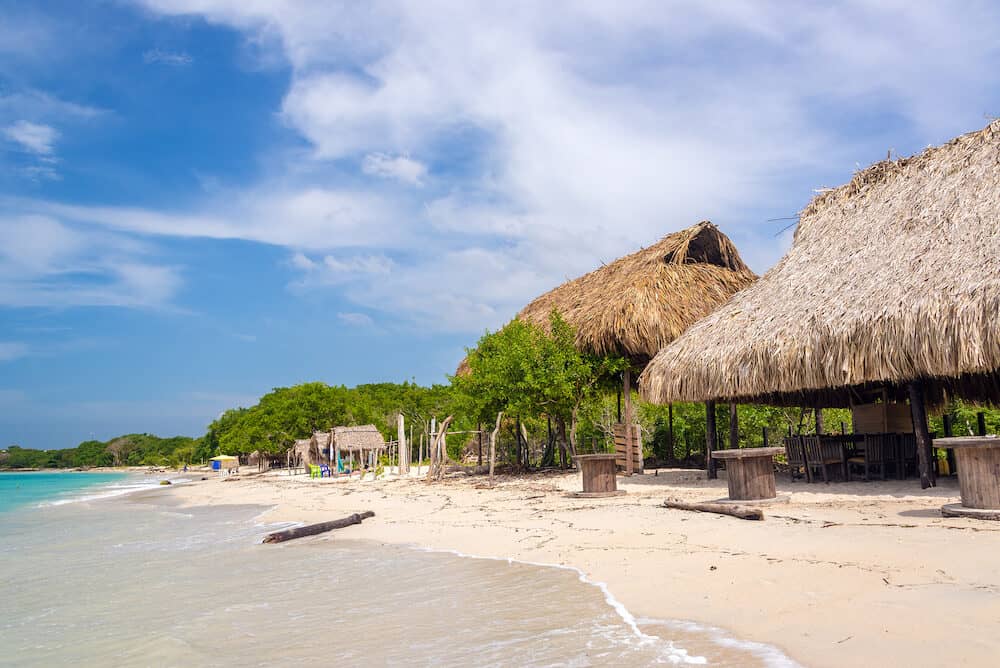
Taganga
Although already gaining popularity amongst backpackers, the small fishing village of Taganga is still considered to be an off the beaten track beach destination. Just 5 km north of Santa Marta, Taganga makes for a great day-trip if you’re looking for a break from the seemingly chaotic city and wanting to enjoy cleaner beaches.
From the bus terminal of Santa Marta, walk out the main entrance and cross the busy highway to catch a colectivo (minibus) that will get you to Taganga in about 40 minutes. If you’re with one or two other people, it’s probably worth it to just get a taxi so you can get to the beaches quicker for about the same price.
The main beach in the Taganga harbor is quite small but a popular spot for swimming for families and Colombian tourists. Taking a short 15 minute walk north, you will find Playa Grande. Although also crowded over weekends and holidays, this beach has great conditions for both swimming and snorkeling, and is definitely much nicer than any beach you will find in Santa Marta.
If you’re really looking for a remote beach experience, you can follow a small trail that runs through the desertous mountains to the right of Taganga beach. The trail leads you through 7 different secluded beaches, and it will be up to you to decide which one seems like the perfect spot! Please be advised that it is suggested to take caution on these routes, as robberies have been reported.
Taganga draws crowds for its nice beaches, but recently its main attraction is that it offers one of the cheapest scuba diving courses in the world.
There are plenty of diving schools in town that offer courses for less than COP$1,000,000, but make sure to do some research so you end up with good instructors, reliable equipment, and will walk home with an official certificate.
From Taganga Beach you can continue your beach adventure to Tayrona National Park by taking a local boat directly to the park for COP$60,000. Or if you’re beached out or short on time, hail a taxi back to Santa Marta or maybe even spend a night at one of the hostels in Taganga, known for some fun partying with like-minded travelers!
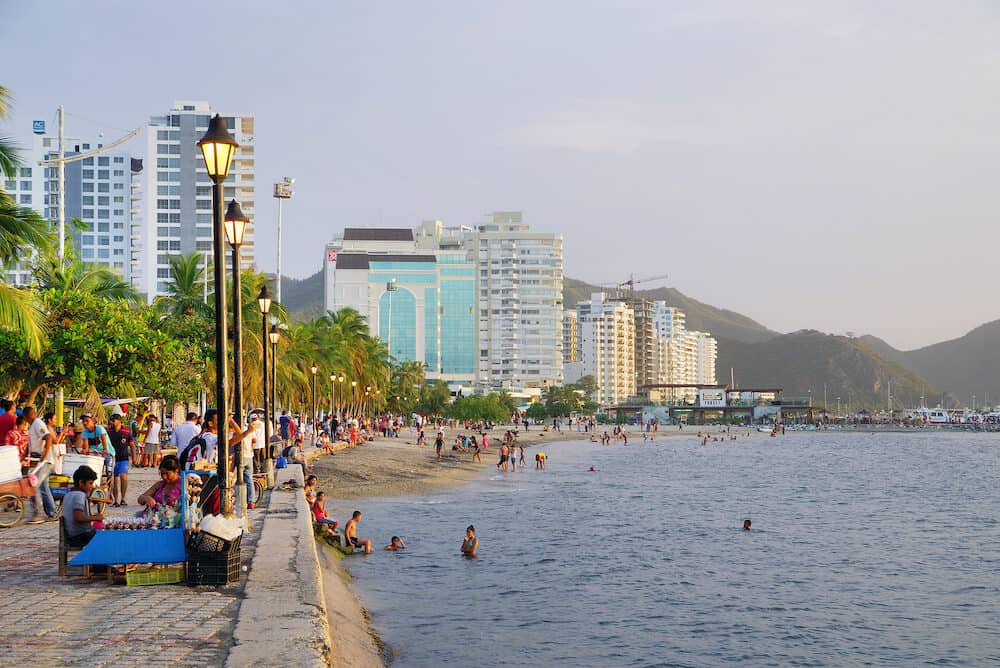
Tayrona National Park
I’m sure you’ve heard a thing or two about the famous coastlines of Tayrona National Park. This park hosts some of the most beautiful beaches in Colombia and is worth every step of the hot and humid trek through the jungle.
The difficulty of arriving eliminates the large crowds generally found at most scenic beaches around the world. Most people travel to Tayrona from Santa Marta, where a bus leaves hourly from the corner of Calle 11 and Carrera 11.
The bus will drop you off at the entrance of the park, where you will need to purchase your entry ticket and put on a layer of sunscreen and mosquito repellant to prepare for your hike in.
Although there is a bus (3,000 COP) that will take you to Cañaveral, the only place accessible by car, most travelers prefer to take the 4 km hike to experience the beauty of the jungle.
From here it is an additional 45 minute walk to Arrecifes beach, which offers quieter campsites a bit inland from the coast. Please note that Arrecifes beach has dangerous riptides so swimming is not permitted.
You will find that most travelers will make the trek all the way to Cabo San Juan campsite, one of the furthest beaches from the entrance but definitely worth the hike in.
From Arrecifes, you can enjoy a nice 15 minute walk enjoying the beach on your right and a forest of palm trees on your left, to La Piscina beach. Then from here it is another 15 minutes of trudging through the sand until you reach Cabo San Juan.
This campground offers accommodation (only tents and hammocks) right on the beach, allowing you to fall asleep and wake up to the sound of crashing waves!
Another bonus to this campsite, is the availability of restaurants and bars, allowing you to have an enjoyable camping experience. Do keep in mind that the food and drinks are expensive, so if you’re a budget traveler, come prepared.
The beaches in Tayrona are definitely the highlight of the park, and you can enjoy the peaceful scenery while soaking up the strong Caribbean sun.
The clear waters make it an excellent place to snorkel, but be wary of the water, as tides can be dangerously strong and not all beaches permit swimming. La Piscina is the most popular beach for swimming and enjoying water sports due to the rocks that break up the strong waves. For the more adventurous travelers, there are many jungle and beach hikes that Tayrona offers.
The most popular being a 1.5 hour uphill trek from Cabo San Juan to the ruins of Pueblito indigenous village. While hiking through the thick rainforest and coconut palms, it is very possible to see some monkeys, frogs, lizards, snakes, and many different species of birds.
Whether you decide to just relax beachside, or throw on your hiking boots on for a humid uphill trek, one can agree that Tayrona National Park is not a place to be missed, especially if you’re looking to experience the true nature and beautiful beaches that Colombia has to offer.

Costeño Beach
Just 5 km away from Tayrona National Park is the little hippie beach haven of Costeño beach. You can enjoy the laid back beach vibe from one of the many hammocks set up along the golden beach, appreciating the abundant shade from the palm trees.
Costeño beach is the place to go if you’re looking to wind down with a beer after completing the treacherous Lost City Trek or a day of hiking in Tayrona National Park.
Although Tayrona is beautiful, and I by no means recommend skipping it, you may find more peace and seclusion in Costeño and appreciate the chilled out backpacker vibe. There is hardly a town here, just a few dirt paths that lead to the different accommodation options right on the beach.
Similar to Tayrona, the water here tends to be choppy with stronger currents, but this actually makes for the best surf conditions on the Caribbean coast. If you’re a beginner, you can get surf lessons for COP$50,000, or you can just enjoy swimming in the relatively mellow white water.
Popular with backpackers alike, there are many different accommodation options that offer anything from hammocks with mosquito nets, to private beach huts.
If headed from Santa Marta, hop on the same bus towards Tayrona (see above) but stay on the bus for about 7 minutes longer, and make sure you let the driver know you want to be dropped off at Costeño beach. It will take about 1.5 hours from Santa Marta.
If already in Tayrona, wait for one of these buses to drop people off at Tayrona and hop on and enjoy the quick ride over.
If completing the Lost City Trek, you can ask the driver to drop you off at Costeño beach, instead of backtracking all the way to Santa Marta. Wherever you started, once you’re dropped off in Costeño beach, it’s a 25 minute walk or quick moto ride to whatever beach accommodation you decide to stay at.
With its close proximity to other popular destinations on the Caribbean coast of Colombia, there is no reason why you should miss out on this wonderful backpacker oasis. Take a break from the hiking shoes, and enjoy the chilled vibe of Costeño beach from a beachside hammock, listening to the pure sounds of the ocean.
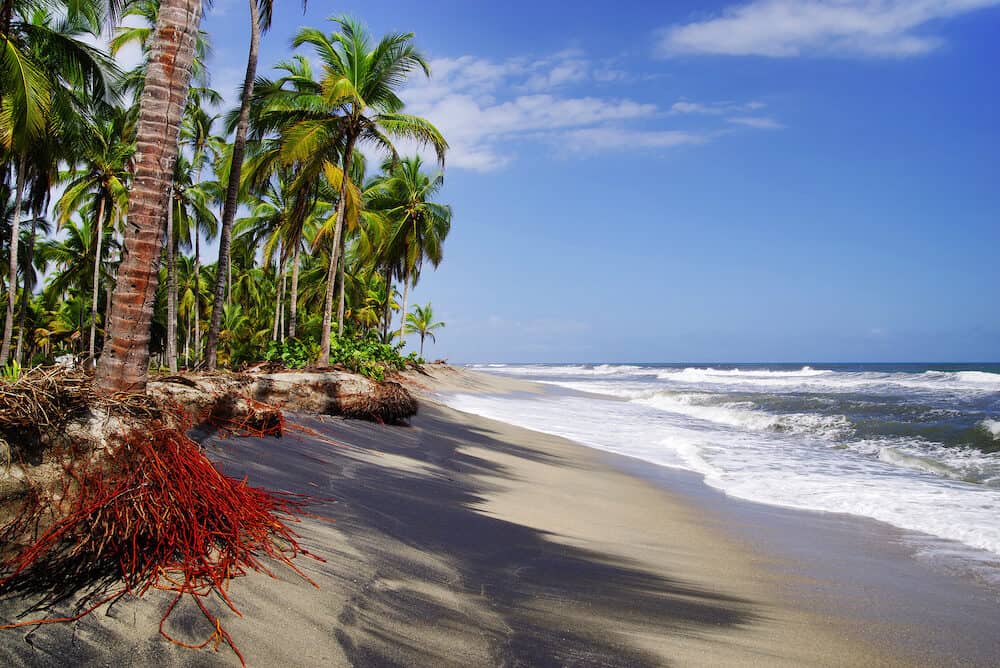
Palomino
Palomino is a small fishing village on the Caribbean coast, further past Tayrona National Park and Costeño beach. In recent years it has gained a lot of popularity amongst travelers, and it is not uncommon to hear backpackers including Palomino in their Colombian beach itinerary.
Aside from its palm-fringed white beaches and year-round warm weather, many people come here for a unique experience of tubing on the Palomino river. Tubes can be rented for very cheap and upon a little hike into the jungle foothills of Sierra Nevada de Santa Marta, you can ride the river back down to sea.
The area surrounding Palomino hosts 7 ecosystems between the beaches of the Caribbean and the glaciers of Sierra Nevadas, making it one of the most ecologically diverse regions in the world!
With not much to do but lay by the beach or take a relaxing tube ride down the river, many travelers will come here for a mellow down after completing any of many treks in the northern region. Due to its recent gain in popularity, a lot of new and nice establishments have been built, from simpler hostels to more luxurious hotels.
Although the tubing experience is unique to Palomino, what makes it even more special is that you can enjoy the glacial peaks of Sierra Nevada de Santa Marta as a backdrop. Where else in the world can you sit back on a Caribbean beach while seeing snow-capped mountains in the distance?
Palomino is accessible from Santa Marta from the corner of Calle 11 and Carretera 11 (like most of the beaches on the Caribbean coast east of Santa Marta.
The bus takes a little under 2 hours and will cost you around COP$10,000. After getting dropped off at the side of the highway, it’s a 20 minute walk or quick moto ride to the beach. Palomino is an absolute must for a truly unique beach experience!
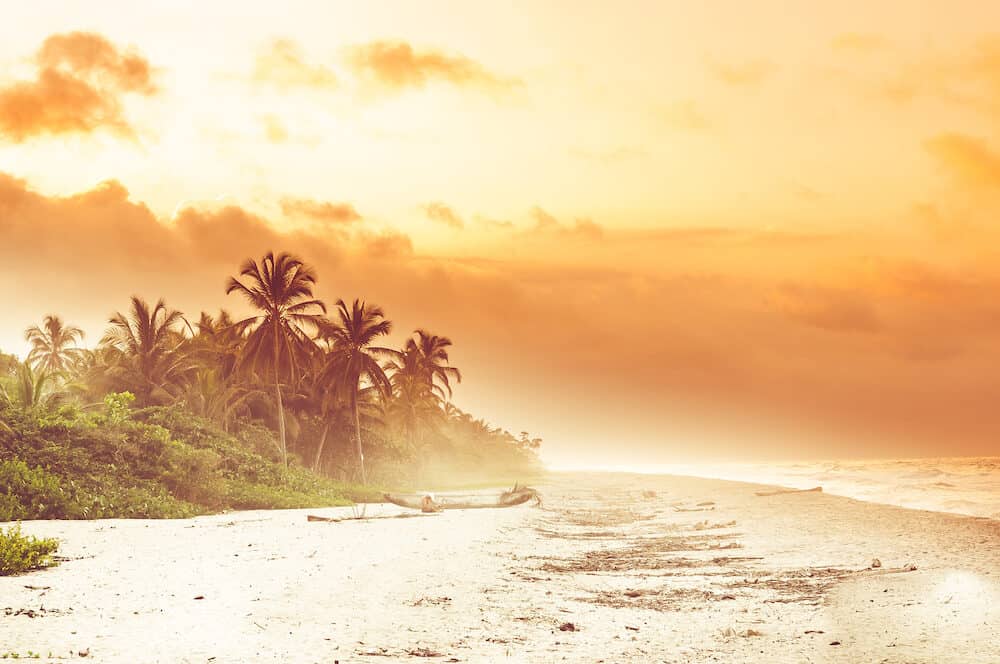
Pilon de Azucar
Cabo de la Vela is a quiet fisherman village in La Guajira peninsula, Colombia’s northern desert region that borders Venezuela.
Travelers increasingly have been making the journey here to experience the unique landscape of where the desert meets the sea, and to learn to kitesurf or experience the indigenous culture of the Wayuu people. Cabo de la Vela is famous for its beautiful sunsets, due to its prime location on a peninsula in the Caribbean Sea.
The sunset can best be viewed from El Faro lighthouse in town. By far the most beautiful beach in Cabo de la Vela is Pilon de Azucar. Featuring bright orange sand and vibrant turquoise waters, this beach is nestled at the base of two hills.
You can find sand dunes on the beach and experience some of the calmest blue waters on the Caribbean coast. For panoramic views of the ocean and endless sand dunes, climb up the small hill right by Pilon de Azucar beach. Although it is quite the journey out here, it is well worth the trip to get to experience this unique, harsh desert landscape overlooking the ocean.
For those very willing travelers, you can take an extra trip further out to Punta Gallinas, the northernmost part of South America. For independent travel, hail a bus headed towards Maicao from Santa Marta and let the drive know you want to be dropped off at Cuatro Vias.
From here you can take a colectivo to the town of Uribia, then a shared SUV colectivo into Cabo de la Vela. Upon arriving to the town, you can hire locals (part of a joint company), who will serve as your driver for visiting the different unique spots of this region.
Although arranging your travel this way is far cheaper, I recommend arranging a multi-day tour with one of the reliable companies from Santa Marta. The company will take care of all the tricky transfers and arrange accommodation, allowing you to simply sit back, relax, and enjoy all the main highlights of the region.
If you’re looking for yet another unique beach landscape, where sand dunes clash with calm water, put aside a few days and make the journey out to Cabo de la Vela, you will not be disappointed!
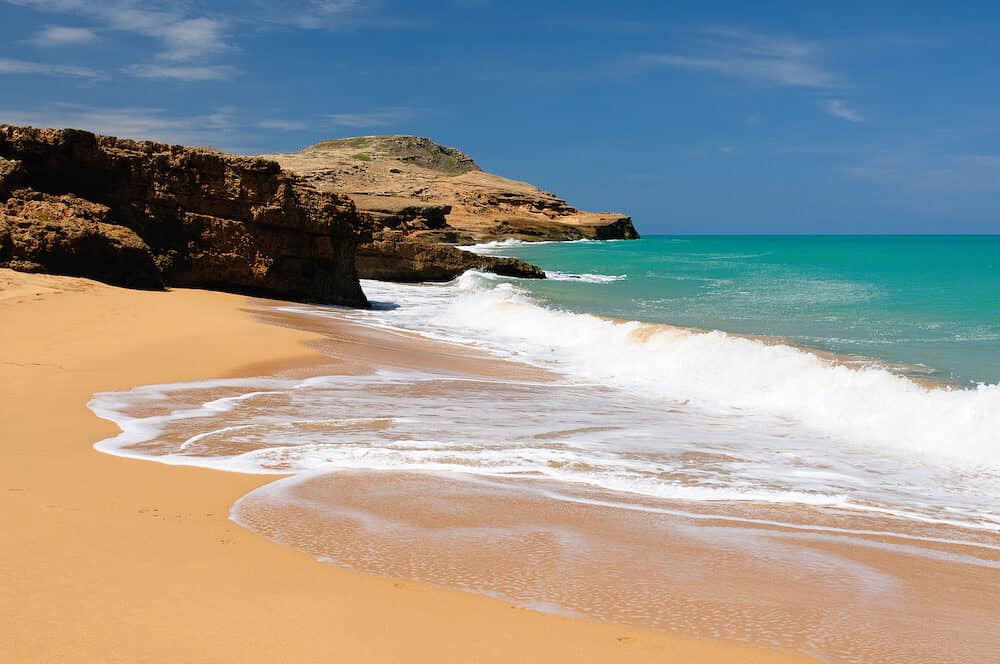
Capurgana
Capurgana is one of the last small towns on the Caribbean coast of Colombia before hitting the border of Panama. Being at the edge of the Darien Gap, the town is surrounded by very dense tropical rainforest and bright green waters.
There are no roads that lead into town as cars are banned here. There are no ATMs and electricity is turned off during the day. You may start to have a sense of the laid back, unhurried jungle beach vibe of this town, allowing you to fully embrace the peacefulness of a Caribbean beach.
The fastest, yet most expensive method of getting here involves a domestic flight to Acandi, from where you can take an hour boat ride to Capurgana. A more budget-friendly option is to take a 7 hour bus from Cartagena to Necocli, and from here take a 1.5 hour boat ride to Capurgana.
Once here, you can enjoy relaxing on the beautiful beaches or go for one of the many jungle hikes offered. Playa Soledad is the main beach here, where you can lay on sparkling white sand, lined with palm trees, and have the Darien jungle as your backdrop. The ocean here is ideal for diving and snorkeling as the coral reefs are well-preserved, and you can expect to see many
colorful fish, and maybe some sharks and turtles as well. For a bit of adventure, I recommend the 3 km hike to El Cielo waterfall. Your hot and humid jungle walk will be rewarded with a dip in the refreshing, crystal clear water at the foot of the waterfall.
Keep an eye out for some howler monkeys, toucans, and parrots. Another popular activity is a visit to the nearby village of Sapzurro, which can be accessed via boat or by a popular 1.5 hour hike through the jungle.
To visit the most picture-perfect beach in this region, trek a bit further out over the border (yes, make sure you have your passports) and you’ll end up at the beautiful beaches of La Miel in Panama. Enjoy being shaded by palm trees and surrounded by the dense Darien Gap jungle.
You won’t want to leave but make sure you give yourself enough time to make the hike all the way back to Capurgana before it gets dark.
No one really wants to get lost in the jungle… To experience a taste of the Caribbean beaches of Central America, Capurgana is a great place to start. If dense jungle and crystal clear ocean is what you desire, this is the place for you!
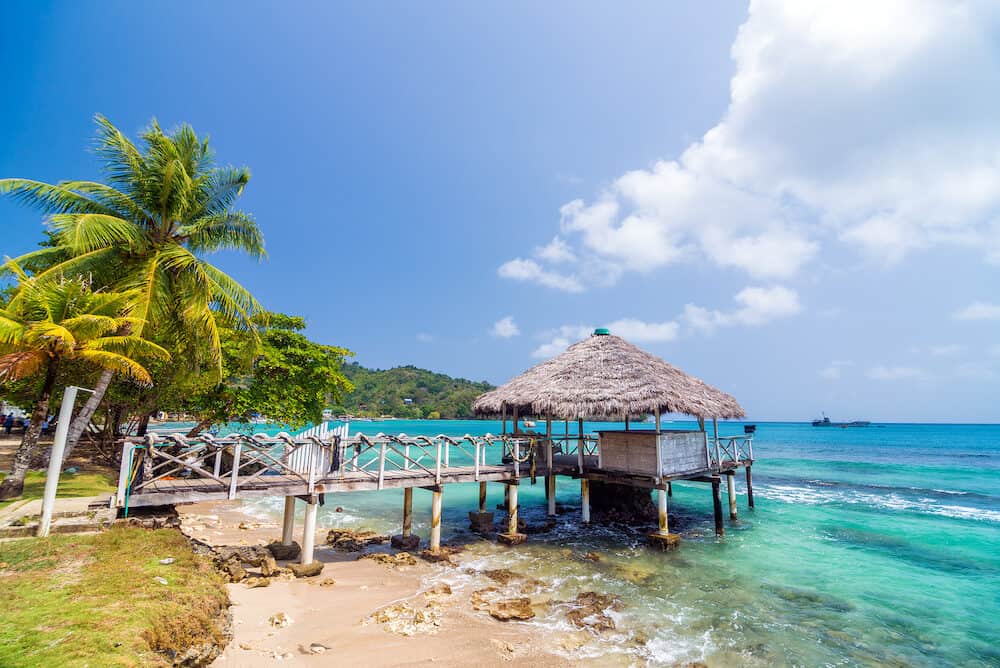
Guachalito (Pacific Coast)
And last but not least is Guachalito, the only Pacific Coast beach on this list, and probably the most “off-the-beaten-path” destination. Here you will not only find turquoise waters and tropical jungle lining the beautiful beaches, but also an abundance of palm trees and exotic flora and fauna.
Being one of the rainiest regions in the country, many unique plants are given the right growing conditions to flourish.
If you happen to visit between July and December, you may catch one of the humpback whales that migrate through here during this time. Guachalito is just a quick 30 minute boat ride west from Nuqui, a small surf-village on the Pacific Coast of Colombia.
You can either fly to Nuqui from Medellin, or take a 18-20 hour boat ride from Buenaventura, just west of Cali. The Pacific Coast of Colombia sees the best waves for ideal surf conditions and you’ll get to experience the unique black sand of the beaches.
This area also allows you to get up and close with the Afro-Colombian culture, which adds to the special charm of this place.
Most of us won’t find the time or effort to make the multi-leg journey here but keep that in mind, as that means far fewer people and a very likely chance to have the beach all to yourselves!
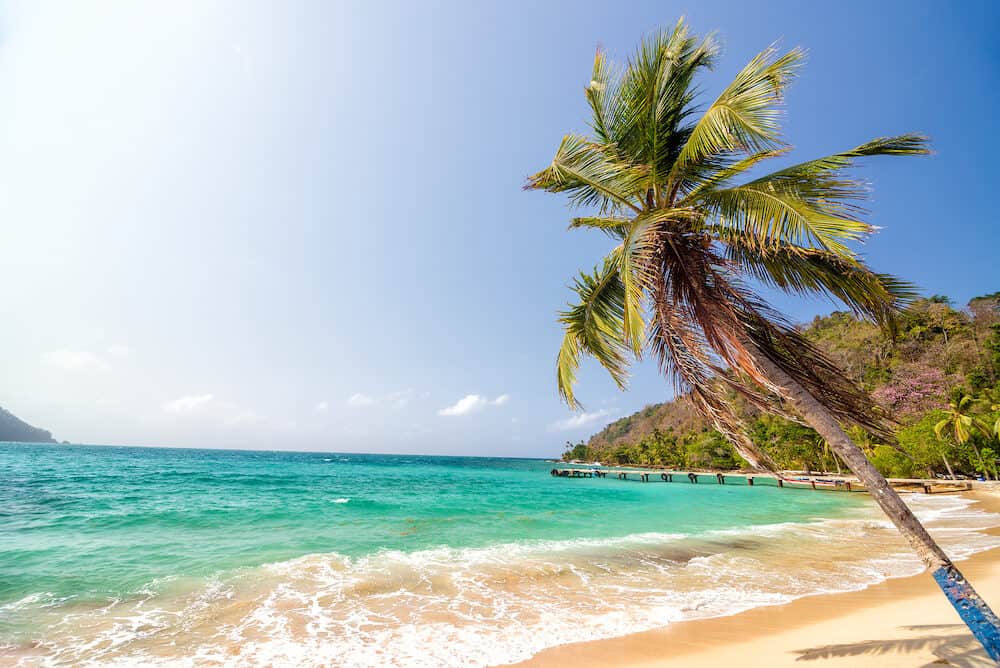
If you’d like to save it for later, please save it to Pinterest.
